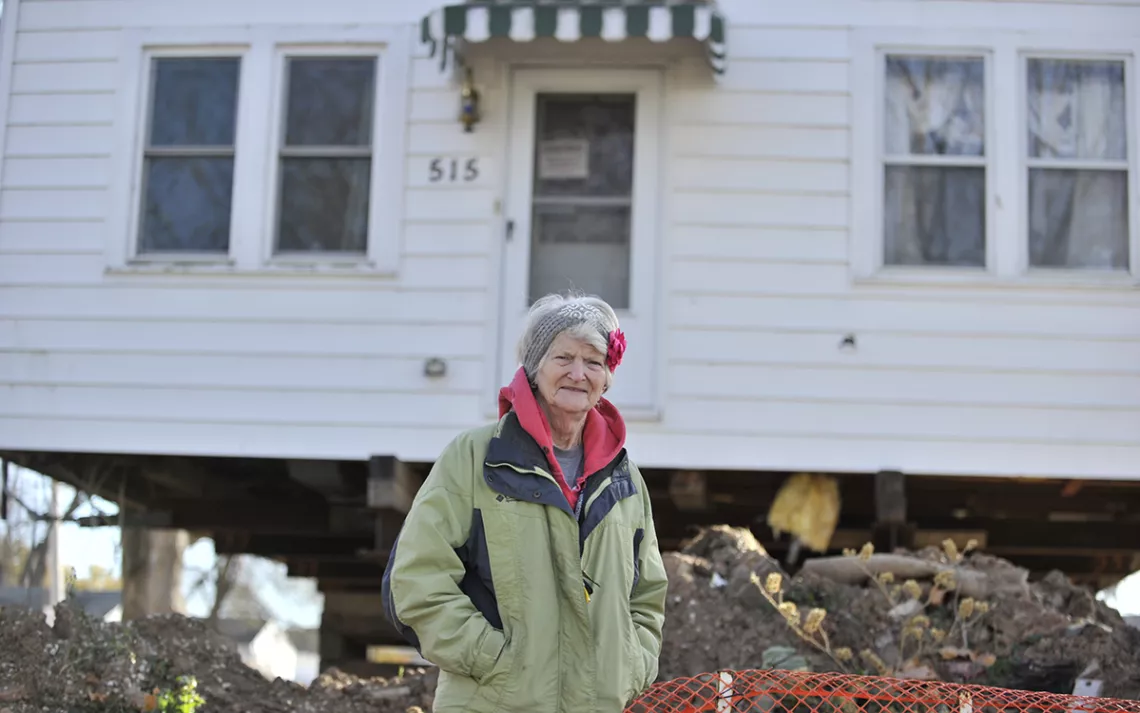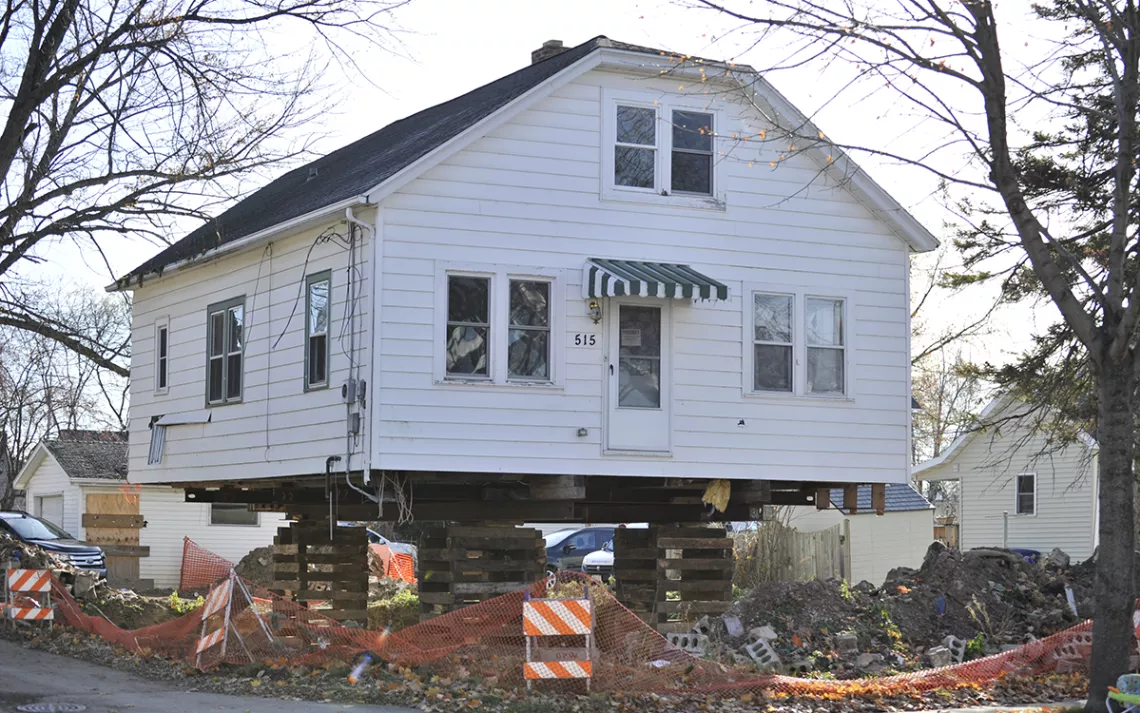After the Flood
Climate resiliency, in practice, is slow, frustrating, expensive, and so very necessary

Since the 2019 flood, Lory Stoneburner has been unable to live in her Green Bay, Wisconsin, home. | Photos by John McCracken
Lory Stoneburner still remembers the rumbling sound.
At 4:30 A.M., she was getting ready for work and noticed her chihuahua Bandit pacing and yelping. Stoneburner, 74, traced the noise to the basement of her Green Bay, Wisconsin, home.
“I opened up the basement door,” says Stoneburner, “and in eight minutes I watched the water go eight feet.”
She frantically called 911. Looking out her front door, she saw water from the street pouring into her Hartung Street basement. “A gush of water going on in my basement, that's what all the rumble was,” she says.
On March 15, 2019, Green Bay’s East River flooded, causing the city to declare a state of emergency for homes near the river. Wisconsin municipalities experienced rapid snowmelt and heavy rainfall that same week, and Governor Tony Evers issued a state-wide emergency.
Stoneburner and Bandit were rescued via boat. Rusty, her cat of 16 years, did not survive the flood.
In a situation sure to become increasingly common in the new age of climate disasters, Stoneburner’s home was one of 36 Green Bay homes that were condemned as a result of the flood, and she hasn’t been able to live in it. Before she can, her home must be elevated and have its foundation rebuilt to meet floodplains standards. She’s resolved to keep her home of over 20 years, but found that rebuilding after a flood isn’t easy, cheap, or straightforward.
The cost of flooding
“I knew this was a flood zone when I bought it,” says Stoneburner, “but there hadn’t been a flood here for I don’t remember how many years.”
Wisconsin, like the rest of the Midwest, is getting wetter and hotter due to climate change. The state’s annual precipitation has increased 17 percent since 1950, according to a recently released Wisconsin Initiative on Climate Change Impacts (WICCI) report. (It also found average temperatures have risen 3°F.) Rainfall in 2019 set a new record for Green Bay’s annual precipitation rate after 133 years.
The 42-mile East River cuts through Green Bay area suburban developments, agricultural communities, and dense east side neighborhoods on John, Cass, Mason, and Hartung Streets, which were submerged in 2019. Twenty years before her basement flooded, Stoneburner said she saw a large flood in 1990 where two people were trapped, and later rescued, under the Mason Street bridge, a few hundred feet from her home.
Stoneburner said she would have abandoned the property if her daughter hadn’t wanted to own it one day. Plus, finding a new place to live was daunting given Green Bay’s housing crisis, another reflection of an ongoing national crisis.
Still, she couldn’t live in a condemned home or in one elevated 16 feet in the air on large wooden slats. In the past three years, she’s had to live with family and friends, and even spent three weeks sleeping in her car while searching for stable housing. It wasn’t until November 2021, two and half years after the flood, that she found an affordable housing unit in a surrounding rural community (even while still paying her Hartung Street mortgage).
Green Bay 2020 city documents show initial estimated repair costs were $51,000. In November, Stoneburner said she had a contract for $67,000 to fix her home, of which her flood insurance should cover roughly $57,000 in repairs. She will have to take on a large financial burden in addition since all basement utilities, from the washer to the furnace, need to be replaced. To pay her mortgage, she works as a school bus driver for the rural village of Denmark and has undergone various surgeries and medical problems since the initial flood.

Stoneburner had to wait for more than a year to get a new foundation. In April, concrete finally poured, but she no longer wants to return.
Rebuilding roadblocks
Calvin Eis, the owner of Eis Structure Movers of Two Rivers, Wisconsin, is Stoneburner’s contractor. He’s responsible for raising the home, something he’s been doing for over 40 years. Eis said Stoneburner’s repairs were delayed due to problems getting subcontractors, increased material prices, and changes to flood plain management at the federal level.
“It just seems every year, it’s a little more complicated,” he said. Planning and regulations aren’t always realistic and the process has increased in price through the years.
When asked if the changes in floodplain management and flood prevention would help shore up future flooding problems, Eis was doubtful. “Mother Nature always wins,” he said.
In late February, plans were approved. By April, the new foundation was finally poured. Even so, Stoneburner said she said she is tired, angry, and frustrated with the whole process. She watched her grandchildren play along the East River and spent years enjoying the physical beauty of the waterfront, but she no longer plans to return to Green Bay. Eventually, her daughter will take over the property.
The most recent US National Climate Assessment, released in 2016, found flooding and extreme weather events can have lasting mental health consequences in affected communities, particularly if they result in degradation of livelihoods or community relocation. The report also found that certain high-risk populations—such as older adults and low-income communities—are often disproportionately affected by, and less resilient to, the health impacts of climate change, from working-class Iowans bearing the brunt of rebuilding after a flood to Floridians dealing with “climate gentrification.”
My home is flooded and I want to sell. What next?
Wisconsin’s annual rainfall continues to rise, and river communities are faced with a dilemma when looking to rebuild.
“We don't know how big the floods are going to continue to get,” said Green Bay Resiliency Coordinator Melissa Schmitz. “So, you elevate your home and are you completely safe? We don’t know. But we also have a housing shortage, so to demolish homes. . . . You have to weigh the pros and the cons.”
A 2019 study of flood insurance and management efforts authored by Columbia Law School’s Sabin Center for Climate Change Law found that not enough is being done to prevent homes impacted by climate disasters from being caught in a “cycle of flood-rebuild-repeat.” Had Stoneburner wanted to walk away from her flooded home, Green Bay wants to work with homeowners to purchase condemned property and convert it into green spaces to retain water and mitigate future floods. However, due to funding and timeline problems, it has yet to see a project through.
After the 2019 flood, Green Bay applied for a Hazard Mitigation grant through FEMA but did not receive the funds either then or in 2020. The number of eligible homes dwindled to nine as homeowners stopped waiting and entered a hot housing market. In 2021, the number of eligible homes was three.
“Time really works against a city or a local municipality when they're competing with housing prices,” said resiliency coordinator Schmitz.
Apart from the home acquisition program, Schmitz said Green Bay is exploring “green infrastructure” projects to increase natural water retention, such as permeable, green streets and vegetative terraces over wider streets.
“The more we do, the more resilient the city is going to be for these high-intensity rain events,” she said.
 The Magazine of The Sierra Club
The Magazine of The Sierra Club



